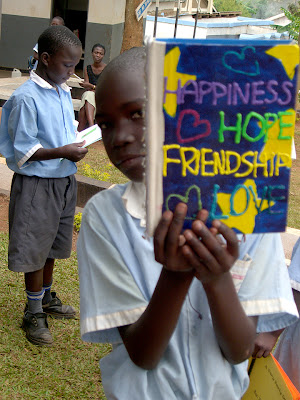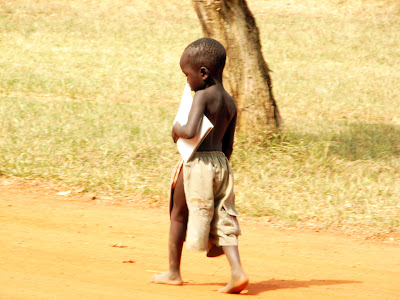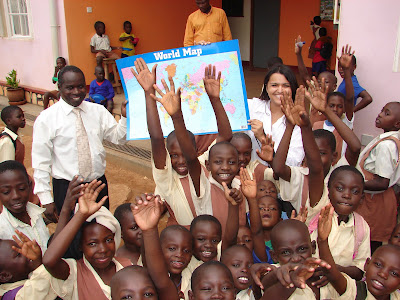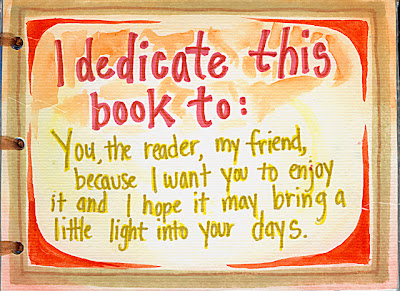Help Make a Difference with Books of Hope
I've got an extraordinary project to share with you today. Books of Hope is a program where schools in the U.S. can work to create books for their sister school in Uganda. There's nothing like a book to change a life - and Books of Hope is changing many, many lives. Classrooms can work to create books for their sister schools - what a fantastic way to teach intercultural understanding, compassion, and learn at the same time! We were lucky enough to sit down and talk with Abha Thakkar, Director of Books of Hope. Here's what she had to say...
WE: Please tell us about Books of Hope...
AT: Books of Hope is a service-learning program that connects U.S. schools with sister schools in war-torn northern Uganda. The three main goals of the project are to provide relevant, high quality instructional material and supplies to Ugandan schools, to provide U.S. classrooms a meaningful writing opportunity and to promote compassion and global understanding among U.S. students. Basically, we find out what kinds of instructional materials that Ugandan schools need - for example, arithmetic and alphabet books for younger students or world history and chemistry books for older students - and then we share this information with the American schools that sign up for the project. The U.S. schools choose their Ugandan sister school based on which Ugandan school needs the books they'd like to make in their classroom. We have about 50 different subject areas that Ugandan schools can request books in, so the project can fit seamlessly into the curriculum of practically every American classroom at every grade level, from first grade to the University level. Then the U.S. students actually research, write, illustrate and bind those books for their Ugandan counterparts. U.S. schools also have the option to fundraise and send donated supplies and published books with their shipment, and then we coordinate the 5 month shipping and distribution process in Uganda. We also provide an opportunity for U.S. schools to get feedback from their sister school in Uganda.

WE: What was the genesis of Books of Hope?
AT: Books of Hope started in 2006 as a way for American students to send letters of hope and support to the Night Commuters, the children of northern Ugandan who were forced to walk upwards of 20 Km a day to urban shelters in order to avoid being abducted by the rebel Lord's Resistance Army. Tens of thousands of children had already been kidnapped and forced to commit brutal atrocities, including murdering their own families and burning down their own villages. Families would send their children to Gulu town or Kitgum every day in order to protect them, but the shelters had almost no resources. The children often slept on ragged mats on dirt or concrete floors, and would have nothing to do while they waited to fall asleep every night.
Books of Hope initially shipped books to these shelters as a way to provide both hope and a constructive distraction during those long nights. As the war thankfully came to an end, the children were able to go back to their villages and their school attendance became more consistent. However, after almost 25 years of war, it was obvious that the reconstruction effort would be long and arduous, and the schools were woefully under-resourced. Most schools have an operating budget of less than $300 per year for anywhere from 400 to 1000 students. They have practically no supplies, no chalkboards, no desks or chairs, and oftentimes don't even have latrines or adequate roofs.
So in 2007 we decided to shift our efforts to supporting the schools that served the former child refugees, and, in order to make the project as relevant and useful as possible, we shifted our focus to sending nonfiction, educational material that could be used by teachers in the classroom. We’ve also started a pilot program to provide sponsorship opportunities to individual students who need support for their tuition and fees - a very modest amount of money keeps a child in school and provides her room and board for an entire year. One of our goals includes purchasing and installing solar panels that will allow our school to at least charge a cell phone, run a light bulb, and eventually power a computer or two.

WE: Who is involved in Books of Hope?
AT: We have lots of different groups involved in Books of Hope. In the United States, we have about 200-300 different schools and organizations making books and donating supplies each year. These range from public schools to private schools to universities and technical colleges, scouting troops, afterschool programs, student organizations, juvenile rehabilitation programs, and even home schooling families. In Uganda, we have almost 20 schools that we've sponsored over the last three years, and our partner organization, the Latigi Orphan Care Center, is staffed by extraordinary Ugandans who themselves are refugees of the war. We officially have 1 part-time administrative assistant in the United States, a part-time contracted staff member in Uganda, and, currently, due to low enrollment numbers this year, an unpaid director who develops and oversees the project (me!).
WE: How can educators facilitate intercultural understanding through Books of Hope?
AT: We hope that intercultural and global understanding among American students is one of the main outcomes of Books of Hope, and we think there are lots of powerful ways to achieve this. We hear lots of great stories about creative approaches taken by U.S. teachers. The war and widespread disease in Uganda truly open students' eyes to the suffering and hardship that so many people in the world face. Many students are not aware of the existence of child soldiers or of the impact of HIV and Malaria in so many poor nations. We often find that our U.S. teachers incorporate both background information on Ugandan culture and tradition with current events lessons about the war. I also think that the projects stirs both curiosity and compassion in students, and, therefore, opens the door to many powerful discussions and explorations. Books of Hope also provides a small set of support material about Uganda and the war, including video and photos that are available to download.

WE: Do schools build relationships outside of Books of Hope?
AT: Generally I don't think that they do, and this is almost entirely because of the utter remoteness and lack of infrastructure of the schools we work with. For example, none of our Ugandan schools have electricity, so therefore they don't have computers, internet, cell phones, or even light bulbs. Many of them are literally in the middle of the African bush. It's often an adventure just simply trying to find them, since paved roads are almost nonexistent.
Many of our schools are located at least 10 Km from the closest town, and most of them are 30-40 Km away. Our schools don't really have the resources for maintaining pen pal relationships, such as pencils, paper, envelopes, postage, and access to a post office. In fact, all of this makes it incredibly difficult for even Books of Hope staff to communicate with our schools in Uganda, and so this last year, we purchased a moped and a camera for our Ugandan staff member to travel out to these remote locations and gather the updates and photographs we need.
We're trying to develop more regular means of communication and increase contact between U.S. schools and their Ugandan sister schools, but the reality is that we are greatly limited by the lack of infrastructure there, and until this improves, relationship-building will likely be on a more limited basis.
WE: How is Books of Hope funded?
AT: Each American school that participates submits a participation fee that's based on the number of boxes they'd like to send to Uganda. Our participation fees are actually very competitive and almost always less expensive than shipping independently with a private freight forwarder (U.S. postal service, UPS, FedEx, DHL, etc), but, of course, with Books of Hope, you also get photos and updates and a guarantee of at least some communication each year. The fee for sending 1 box is $125, the fee for sending 2-3 boxes is $225, and every additional box beyond that is $50 more. This fee does not include the cost of domestic shipping to our warehouse in the United States or the cost of the box (approximately $3.25 each).
WE: How has this program changed lives, in Uganda and in the U.S.?
AT: We get an enormous amount of positive feedback from schools in both the United States and in Uganda. To date, we've involved about 60,000 American students. Our U.S. teachers generally love the program, and we often hear reports that they've never seen their students so motivated to write. Students often want to make more than one book, and work very hard at making their books beautiful and special for the Ugandan students who will be reading them. I've had a few opportunities to visit U.S. classrooms that are participating in the project, and I'm honestly just astonished at the quality and sheer number of questions that American students have about the Ugandan students' experiences. I think the project really stimulates both the hearts and minds of our U.S. participants.
In terms of our impact in Uganda, we haven't been around long enough to do a formal evaluation, but, to be honest, when you're working in a place that is so desperately poor and broken, every little bit matters. Every page of written words is more than they had before, every piece of chalk is necessary, every modest monetary donation keeps the school open a little bit longer. To date, we've donated almost $10,000 in cash (with which we've purchased desks and chairs, latrines, two computers, a solar panel system, and other very necessary supplies), $25,000 in school supplies, and an untold number of both student-made and published books (probably close to 50,000) to our Ugandan schools, and we are often the only support these schools receive. To date, we've supported 20 Ugandan schools, touching the lives of at least 15,000 students and teachers.

WE: Is there anything else you'd like to share with us?
AT: Just that the project is facing some hard times, and, although on the surface, our participation fees may seem daunting for schools facing very real budgetary limitations, we've found that oftentimes the community surrounding a school is thrilled to support such a project. A lot of our American schools who want to participate find sponsors in their PTA, their local Rotary or Kiwanis club, or even businesses and their local Chamber of Commerce. These groups happily pay for the participation fees in order to make this opportunity available to the students in their community. So, if you're interested in participating, but you aren't sure whether your school can afford it, I'd encourage you to ask around. You might be surprised how quickly you can find a community group that would like to support your participation in this kind of service-learning project.
I also understand that testing pressures make classroom time very limited. As a former classroom teacher myself, I completely understand the many factors that teachers need to weigh when deciding which units they'll teach in their classroom. Again, I'd encourage you to look through the materials, because I think you'll find that the project is designed in such a way that it allows teachers ultimate flexibility. Instead of ADDING Books of Hope as an additional burden, you can easily transform a current nonfiction writing assignment into a simple "book" that Ugandan children could benefit from as well. I've seen our American teachers do some incredibly creative things with the project, and it's always great to hear how it has inspired them, as well.
WE: Thanks so very much, Abha! Books of Hope is an incredible organization, with such commendable goals and outcomes. BRAVA!
For more information, please see:
booksofhope.org/
Here is a great Guide that was shared with us on How to Start a School Supply Drive in Your Community.
-

- Log in to post comments


















